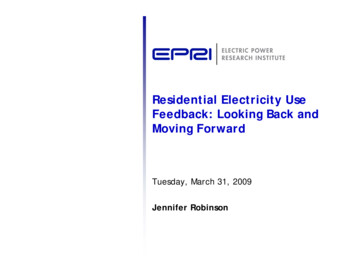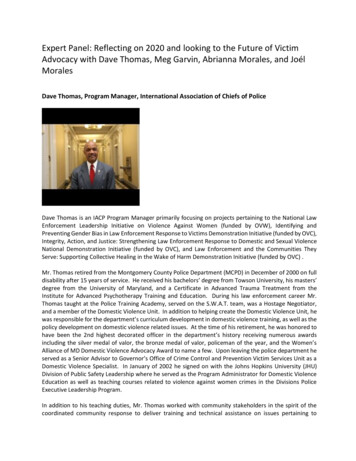
Transcription
DOI: 10.24843/JH.2018.v22.i01.p22ISSN: 2302-920XJurnal Humanis, Fakultas Ilmu Budaya UnudVol 22.1 Pebruari 2018: 147-151Similes In Novel Looking For Alaska By John GreenNi Putu Antary Octha Sri Devi1*, I Gede Budiasa2, A. A. Sagung Shanti Sari Dewi3English Department – Faculty of Arts – Udayana University1[antaryoctha95@gmail.com] Corresponding AuthorAbstractThe paper entitled “Similes in Novel Looking for Alaska by John Green” focuses on thekinds of simile and the meaning of simile found in the novel. The data was collected byreading the novel intensively, giving underline and taking note the similes found in thenovel. The collected data was analyzed using qualitative method based on theory offigurative language, particularly simile. The main theory used in the analysis of thekinds of simile is proposed by Zhang Xiu Guo in a book entitled English Rhetoric (2005)and the analysis of type of meanings uses theory proposed by Leech (1981) in his bookentitled Semantics. From the analysis of the data, there were two types of similes found,namely simile in terms of function and structure. Functionally there were three kinds ofsimile found, they are descriptive, illuminative, and illustrative similes, meanwhilestructurally two kinds of similes were identified, they are closed and open similes. Themeanings of similes found are connotative and conceptual meanings.Keyword: Simile, Types, MeaningAbstrakJudul dari penelitian ini adalah Similes pada novel “ Looking For Alaska By JohnGreen” berfokus pada jenis simile, dan makna simile yang ditemukan dalam novel ini.Pengumpulan data dengan membaca novel secara intensif, memberikan garis bawahdan mencatat similes yang ditemukan dalam novel tersebut. Data yang terkumpuldianalisis dengan menggunakan metode kualitatif berdasarkan teori bahasa kiasan,terutama simile. Teori utama yang digunakan dalam analisis jenis simile diusulkan olehZhang Xiu Guo dalam sebuah buku berjudul English Rhetoric (2005: 158-159) danjenis analisis makna menggunakan teori yang diajukan oleh Leech (1981) dalambukunya yang berjudul Simantic. Dari analisis data, simile dapat dikelompokkanmenjadi dua jenis: simile dalam hal fungsi dan struktur. Secara fungsional simile dapatdiklasifikasikan dalam tiga jenis: deskriptif, iluminatif, dan ilustratif. Dari segi struktursimile bisa dibagi dalam dua jenis, simile tertutup dan terbuka. Makna dari simile yangditemukan adalah makna konotatif dan konseptual.Kata kunci: Similie, Tipe, Arti1.Background of the StudyFigurative language or figure ofspeech is a word or phrase used in adifferent way from its usual meaning inorder to create a particular mental pictureeffect (Hornby, 2005:527). Meaning isthe thing or idea that people wishes tocommunicate to you by what they say or147
DOI: r’sDictionary, 2005:951). Larson (1997)states that there are many kinds offigurative language such as: metonymy,synecdoche,idiom,euphemism,hyperbole, metaphors, and simile.One of the figurative languages likesimile presents two comparisons in thesemantic structure. It is referring to howto use the word “like” or “as” to make thecomparison within one thing to another,and also to compare one object withanother to suggest they are alike. Asimile is a figure of speech that directlycompares two things and is always statedclearly through comparison by using ofthe word “like” or “as”. For example,“she is beautiful like a sun flower. Thissentence of simile can image that the girlis compared as a sun flower. “She isbeautiful like a sun flower” can mean thatthe girl is a pretty person. It also meansthat every beautiful person can becompared to a sun flower. It is becausethe sun flower is the symbol of beauty. Itis very interesting to find the features orcharacteristic of something. Simile andfigurative simile are used in variousways, such as in literature or media.Simile is usually used in poem, songlyrics, advertisement, short stories,novels, etc. Novel is a kind of media thatis used to express feeling. Novel is astory long enough to fill a completebook, in which the characters and eventsareusuallyimaginary(Hornby,2005:1039). A novel was chosen as thedata of this study in order to get a lot ofsimiles. The novel “Looking for Alaska”written by John Green is selected as thedata source of this study rather than otherauthor because he is one of the authorswho has bestselling novel and alsoalmost in all of his novels contain a lotof examples of simile. It is interesting toidentify the similes that are used in thisnovel in order to imagine about thefeelings of the author and sentences inISSN: 2302-920XJurnal Humanis, Fakultas Ilmu Budaya UnudVol 22.1 Pebruari 2018: 147-151this novel are easy to understand by thereaders. Therefore, it is very interestingto analyze the similes found in the novel.2.Problem of the studyIn this study, there are two problemsformulated to analyse the similes used inthe novel “Looking for Alaska” :1. What types of similes are found inthe novel “Looking for Alaska” interms of function and structure?2. How is the simile implied in terms ofmeaning in the novel “Looking forAlaska” ?3.Aims of the StudyThe aims of the current study are asfollows:1. To identify the kinds of similefound in the novel “Looking ForAlaska” in terms of function andstructure2. To analyze the types of meaning ofsimile in the novel “Looking ForAlaska”.4.Research MethodThe research method in this studyconsists of data source, method andtechnique of collecting data, method andtechnique of analyzing the data, andmethod and technique of presenting data.4.1Data sourceThe primary data in this studywere taken from a novel. The data of thisstudy was collected from a novel writtenby John Green entitled Looking forAlaska. This novel contains manysimiles. Looking for Alaska waseventually completed and published in2005. It is a coming-of-age romancenovel about a teen Miles. The novel isinspired by Green’s time at IndianSprings. Unlike other young adultwriters, Green has broadened the horizonof young adult novels subjects matter.148
DOI: 10.24843/JH.2018.v22.i01.p22This novel explainsphilosophicalapproach to the issues of teenager’s life.The unorthodox form and content of thenovel had it earned the American LibraryAssociation’s Michael L. Printz Award in2006. The book made a record forstaying at New York Times as best selleras list for the span of 7 years. Lookingfor Alaska consists of 268 pages with 59chapters. The novel follows Miles Halter,a new junior at the school who isnavigating the adolescent world ofmaking friends, pranking the wealthy daystudents, finding romance, and searchingfor The Great Perhaps. There are manysimiles in this novel and make this storyinteresting for the readers.4.2 Method and Technique ofCollecting DataThe method of collecting datawas documentation. The techniques incollecting data are; first, reading the datacarefully and rereading in order to getunderstanding of this novel; second,giving underline and taking a note of allsimiles found in the novel page by page;third taking all of similes in the novel;and the fourth, analyzing the data thathave been classified4.3 Method and Technique ofAnalyzing DataThe collected data were analyzed byusing the descriptive method proposed byGuo and use the theory of meaningproposed by Leech. In this study, therewere several steps taken in analyzing thedata. First, reading and understanding theobject of the study; it was very importantto read the whole novel carefully, and tryto understand the message or the mainpoint of the novel. After that, the dataanalysis started by classifying the datainto the type of simile. Underlining thesentences and taking a note in order toidentify simile words. Classifying kindsof simile in term of function, and in termISSN: 2302-920XJurnal Humanis, Fakultas Ilmu Budaya UnudVol 22.1 Pebruari 2018: 147-151of structure. Next, the meaning of thesimile in the novel was described,identified, and analyzed based on thetheory. By analyzing the simile, what thenovel means by the author could beinterpreted.5. Analysis5.1 Kinds of simile in the novelLooking for Alaska1. In terms of Functiona. Descriptive similesAlaska made O with her lips, moving hermouth like a goldfish eating (chapter6:55). This simile refers to descriptivesimile because the condition of her lipsexplains the goldfish eating of the tightwhich can be seen from the word O.b. Illuminative SimilesMy head still hurt, and sizeable knotabove my left temple looked, the colonelthough,likeaminiaturizedtopographical map Macedonia.(Green,2011:83).This simile belongs to illuminative raphicalmapMacedonia being the sizeable knot sothat simile gives deeper insight into howthe sizeable knot of Miles’ head.c.Illustrative similesAlaska followed the smoke ringswith her fingers, stabbing at them like akid trying to pop bubbles (Green,2011:70).This simile belongs to illustrativesimile because it illustrates how Alaskapops the bubble.2.a.In terms of StructureOpen SimileWe ran like we had golden shoes(Green, 2011:128).149
DOI: 10.24843/JH.2018.v22.i01.p22This simile refers to open similebecause the qualities or characteristics ofgolden shoes unstated.b. Closed SimileA cylindrical orange object gettingbigger and bigger, like a fastapproaching sun (Green, 2011:76).This simile occurs as closed similebecause the characteristic of a sun isclearly stated, as being orange object,basket ball.5.2 Meaning of Simile in the novelLooking for AlaskaA. Conceptual MeaningAlaska made O with her lips, movingher mouth like a goldfish eating (Green,2011:55).The sentence above contains aconceptual meaning as all of themeanings in the sentence are alreadydescribed in the sentence. The concept ofa goldfish is explained that it can live inany kind of water and got round shapefor its mouth. The sentence representshow Alaska looks like a gold fish eatingin the water. Fish that is eating somethingwill make a circle in mouth. The sentenceexplains that Alaska makes O with herlips, as condition shape of mouth Alaskais clearly stated as eating fish.B. Connotative Meaning1. Grabbed it with both hands andcollapsed into chair with a series ofquick, shallow breath like a womanin labour (Green, 2011:86).This sentence has connotativemeaning as it cannot be interpretedliterally. The phrase “like woman inlabour” gives deeper meaning of thecondition of a woman who is giving birthwith a heavy breath. The author of thisnovel explains that Hyde is very oldlecturer, and this condition cannot beISSN: 2302-920XJurnal Humanis, Fakultas Ilmu Budaya UnudVol 22.1 Pebruari 2018: 147-151supposed to be allowed to walk so faraway but he has to walk into theclassroom, and makes him feel veryexhausted because he walks too far. It isa connotative meaning because meaningof this sentence cannot be understoodliterally; everyone will translate itdifferently depending on their knowledgeor experience.6. ConclusionBased on the foregoing analysis anddiscussion, the following points can bedrawn as conclusion:Functionally the similes are descriptive,illuminative and illustrative simile.Descriptive similes use vivid andeffective description; they can draw sharppictures in the mind with brevity.Illuminative similes give deeper insightinto persons, things, ideas, even problemsthrough suggestive association. They areused to throw light into what wouldotherwise to be inconceivable to ordinarypeople; and Illustrative similes explainabstract or complicated ideas ofprocesses in simple, concrete imagery.They are often used in scientific,technological writing. Structurally theyare open and close simile. Open similesrefers to the simile with which thecommon quality of the two unlikeelements is unstated. It is left for thereaders or listeners to comprehend; andclosed similes refer to the simile withwhich the common quality or the groundof the comparison is clearly stated.Meanwhile as far as the meanings ofsimile are concerned, they are conceptualand connotative meanings. Conceptualmeaning is the clear and logicaldefinition of a word based on thestructure and form of the word.Connotativemeaningisthecommunicative value that an expressionhas by virtue of what it refers to, overand above its purely conceptual content.150
DOI: 10.24843/JH.2018.v22.i01.p227.ISSN: 2302-920XJurnal Humanis, Fakultas Ilmu Budaya UnudVol 22.1 Pebruari 2018: 147-151BibliographyChomsky, Noam (1957). SyntacticStructure. Martino Fine Book, USA.Hornby, Albert Sidney. (2010). OxfordAdvanced Learner’s Dictionary. EighthEdition. Oxford University Press,Oxford.Larson, Mildred L. 1997. Meaning-BasedTranslation.UniversityPressofAmerica. Maryland.Leech, Geoffrey. (1979).Penguin Books. Auckland.Semantics.Xiu Guo, Zhang. (2005). Englishrhetoric. “Qing Hua Xue Chu Ban She”.Tsinghua University Press. Beijing151
by John Green entitled Looking for Alaska. This novel contains many similes. Looking for Alaska was eventually completed and published in 2005. It is a coming-of-age romance novel about a teen Miles. The novel is inspired by Green’s time at Indian Springs. Unlike o











